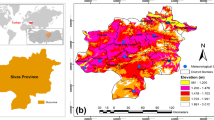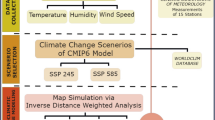Abstract
Biocomfort is limit values in which people feel comfortable in environmental conditions such as wind, humidity, temperature, and precipitation. Bioclimatic comfort areas are used in urban planning, rural planning, tourism purposes, urban area’s residential area, and landscape architecture. Bioclimatic comfort maps were made according to PET (Physiological Equivalent Temperature) index from meteorological station; also, data were obtained from satellite images to determine the bioclimatic comfort structure of the urban area in Bursa. For this data, average wind, temperature, and relative humidity values were converted to Geographic Information Systems (GIS) using ArcView GIS ™ 10 software and create thermal perception maps. The study integrates remote sensing (RS) and GIS to analyze land cover and use change in Bursa defining bioclimatic comfort. Utilizing Landsat (7 ETM and 8 OLITIRS) satellite data and Digital Elevation Model (DEM), the change map was analyzed and produced in 2002–2016. The objective was to understand the suitability of Change Vector Analysis (CVA) and elevation parameters in the region. The results indicate the appropriateness of change in vector analysis. With the help of a bioclimatic comfort conditions, map taking into account the temperature, humidity, and rainfall data and bioclimatic comfort zone for the 12-year period perceived for 30 years. The result maps of the study may serve as the basis for sustainable urban planning studies for Bursa.








Similar content being viewed by others
References
Asgarian A, Amiri BJ, Sakieh Y (2015) Assessing the effect of green cover spatial patterns on urban land surface temperature using landscape metrics approach. Urban Ecosyst 18(1):209–222 https://rd.springer.com/article/10.1007/s11252-014-0387-7. Accessed 02 Oct 2018
Bokaie M, Zarkesh MK, Arasteh PD, Hosseini A (2016) Assessment of Urban Heat Island based on the relationship between land surface temperature and land use/land cover in Tehran. Sustain Cities Soc 23:94–104 https://www.sciencedirect.com/science/article/pii/S2210670716300403. Accessed 10 Dec 2018
Butt A, Shabbir R, Ahmad SS, Aziz N (2015) Land use change mapping and analysis using Remote Sensing and GIS: a case study of Simly watershed, Islamabad, Pakistan. Egypt J Remote Sens Space Sci 18:251–259 https://www.sciencedirect.com/science/article/pii/S1110982315000332. Accessed 12 Oct 2018
Cetin M (2015a) Determining the bioclimatic comfort in Kastamonu City. Environ Monit Assess 187(10):640 http://link.springer.com/article/10.1007%2Fs10661-015-4861-3. Accessed 07 Dec 2018
Cetin M (2015b) Evaluation of the sustainable tourism potential of a protected area for landscape planning: a case study of the ancient city of Pompeipolis in Kastamonu. Int J Sust Dev World 22(6):490–495 https://www.tandfonline.com/doi/abs/10.1080/13504509.2015.1081651?src=recsys&journalCode=tsdw20. Accessed 12 Dec 2018
Cetin M (2015c) Using GIS analysis to assess urban green space in terms of accessibility: case study in Kutahya. Int J Sust Dev World 22(5):420–424 https://www.tandfonline.com/doi/abs/10.1080/13504509.2015.1061066. Accessed 15 Dec 2018
Cetin M (2016a) Determination of bioclimatic comfort areas in landscape planning: a case study of Cide Coastline. Turk J Agric-Food Sci Technol 4(9):800–804 http://www.agrifoodscience.com/index.php/TURJAF/article/view/872. Accessed 05 Dec 2018
Cetin M (2016b) Sustainability of urban coastal area management: a case study on Cide. J Sustain For 35(7):527–541. https://doi.org/10.1080/10549811.2016.1228072
Cetin M, Sevik H (2016) Assessing potential areas of ecotourism through a case study in Ilgaz Mountain National Park, InTech, Chapter 5, In: Butowski L (ed) 190, ISBN:978-953-51-2281-4, 81-110
Cetin M, Zeren I (2016) Evaluation of the value of biocomfort for Kastamonu-Inebolu. International Conference GREDIT’2016 – Green Development Infrastructure Technology, Poster section 4: Management of Urban and Industrial Waste, Climate Change – Biodiversity – Efficiency, ISBN 978-608-4624-21-9, 31.03 and 01.04 2016, p4–35, page: 310, Skopje, Macedonia
Cetin M, Topay M, Kaya LG, Yılmaz B (2010) Efficiency of bioclimatic comfort in landscape planning process: case of Kutahya. Turk J For 1(1):83–95
Cetin M, Sevik H, Zeren I (2017) Chapter 7_ Coastal biocomfort mapping for Doganyurt. OMICS, e-Books International, In: The effects of environmental policies on sustainability: theory and methods. USA, pp 51–55
Cetin M, Adiguzel F, Kaya O, Sahap A (2018a) Mapping of bioclimatic comfort for potential planning using GIS in Aydin. Environ Dev Sustain 20(1):361–375. https://doi.org/10.1007/s10668-016-9885-5
Cetin M, Yildirim E, Canturk U, Sevik H (2018b) Chapter 25: Investigation of bioclimatic comfort area of Elazig city centre. In book title: Recent researches in science and landscape management, Cambridge Scholars Publishing. ISBN (10): 1-5275-1087-5, ISBN (13): 978-1-5275-1087-6, Lady Stephenson Library, Newcastle upon Tyne, NE6 2PA, UK. Page: 324-333
Cetin M, Zeren I, Sevik H, Cakir C, Akpinar H (2018c) A study on the determination of the natural park’s sustainable tourism potential. Environ Monit Assess 190(3):167. https://doi.org/10.1007/s10661-018-6534-5
Cetin M, Onac AK, Sevik H, Canturk U, Akpinar H (2018d) Chronicles and geoheritage of the ancient Roman city of Pompeiopolis: a landscape plan. Arab J Geosci 11:798. https://doi.org/10.1007/s12517-018-4170-6 https://link.springer.com/article/10.1007/s12517-018-4170-6. Accessed 10 Jan 2019
Cetin M, Adiguzel F, Gungor S, Kaya E, Sancar MS (2019a) Evaluation of thermal climatic region areas in terms of building density in urban management and planning for Burdur, Turkey. Air Qual Atmos Health 1–10. https://doi.org/10.1007/s11869-019-00727-3; https://link.springer.com/content/pdf/10.1007%2Fs11869-019-00727-3.pdf. Accessed 25 July 2019
Cetin M, Onac AK, Sevik H, Sen B (2019b) Temporal and regional change of some air pollution parameters in Bursa. Air Qual Atmos Health 12(3):311–316 https://link.springer.com/article/10.1007/s11869-018-00657-6
Cetin M, Ozel HB, Cali K, Canturk U (2019c) Biocomforts in urban landscape planning studies. In: Aksoy Y (ed) Climate change and cities structural environment and green areas, ISBN. 978-605-81019-4-4, Ozgur Ozturk DAKAM Publications, 681 pages, chapter page: 177–193, April 2019, Istanbul
Chen XL, Zhao HM, Li PX, Yin ZY (2006) Remote sensing image-based analysis of the relationship between urban heat island and land use/cover changes. Remote Sens Environ 104:133–146 https://www.sciencedirect.com/science/article/abs/pii/S0034425706001787. Accessed 15 Dec 2018
Chung YS, Kim HS (2019) Observations on changes in Korean Changma rain associated with climate warming in 2017 and 2018. Air Qual Atmos Health 12(2):197–215 https://rd.springer.com/article/10.1007/s11869-018-00658-5. Accessed 02 Feb 2019
ESRI (2014) How hot spot analysis: Getis-Ord Gi* (Spatial Statistics) works and density analysis. http://resources.arcgis.com/en/help/main/10.2/index.html (20.02.2014)
Fan Y, Li Y, Yin S (2018) Interaction of multiple urban heat island circulations under idealised settings. Build Environ 134:10–20 https://www.sciencedirect.com/science/article/abs/pii/S0360132318301008. Accessed 05 Jan 2019
Gilmore S, Saleem A, Dewan A (2015) Effectiveness of DOS (Dark-Object Subtraction) method and water index techniques to map wetlands in a rapidly urbanising megacity with Landsat 8 data. Research@ Locate ’15., 100–108. https://espace.curtin.edu.au/handle/20.500.11937/43918. Accessed 07 Dec 2018
Haque MI, Basak R (2017) Land cover change detection using GIS and remote sensing techniques: a spatiotemporal study on Tanguar Haor, Sunamganj, Bangladesh. Egypt J Remote Sens Space Sci 20:251–263 https://www.sciencedirect.com/science/article/pii/S1110982316301533. Accessed 06 Oct 2018
Insaf TZ, Lin S, Sheridan SC (2013) Climate trends in indices for temperature and precipitation across New York State, 1948–2008. Air Qual Atmos Health 6(1):247–257 https://rd.springer.com/article/10.1007/s11869-011-0168-x. Accessed 11 Dec 2018
Kaya E, Agca M, Adiguzel F, Cetin M (2018) Spatial data analysis with R programming for environment. Hum Ecol Risk Assess. https://doi.org/10.1080/10807039.2018.1470896
Kim HS, Chung YS, Cho JH (2017) Long-term variations of dust storms and associated dustfall and related climate factors in Korea during 1997~ 2016. Air Qual Atmos Health 10(10):1269–1280 https://rd.springer.com/article/10.1007/s11869-017-0513-9. Accessed 13 Oct 2018
Li YY, Zhang H, Kainz W (2012) Monitoring patterns of urban heat islands of the fast growing Shanghai metropolis, China: using time-series of Landsat TM/ETM+ data. Int J Appl Earth Obs 9:127–138 https://www.sciencedirect.com/science/article/pii/S0303243412000979. Accessed 17 Oct 2018
Li M, Zhou M, Yang J, Yin P, Wang B, Liu Q (2019) Temperature, temperature extremes, and cause-specific respiratory mortality in China: a multi-city time series analysis. Air Qual Atmos Health 12(5):539–548 https://rd.springer.com/article/10.1007/s11869-019-00670-3. Accessed 02 Feb 2019
Lin CY, Chen WC, Chang PL, Sheng YF (2011) Impact of the urban heat island effect on precipitation over a complex geographic environment in northern Taiwan. J Appl Meteorol Climatol 50(2):339–353 https://journals.ametsoc.org/doi/full/10.1175/2010JAMC2504.1. Accessed 07 Oct 2018
Mondal I, Thakur S, Ghosh P, De TK, Bandyopadhyay J (2019) Land Use/Land Cover Modeling of Sagar Island, India using remote sensing and GIS technique. Emer Tech Data Min Info Sec 771–785. https://rd.springer.com/chapter/10.1007/978-981-13-1951-8_69. Accessed 02 Feb 2019
Scharsich V, Mtata K, Hauhs M, Lange H, Bogner C (2017) Analysing land cover and land use change in the Matobo National Park and surroundings in Zimbabwe. Remote Sens Environ 194:278–286 https://www.sciencedirect.com/science/article/abs/pii/S0034425717301414. Accessed 09 Dec 2018
Sesnie SE, Dickson BG, Rosenstock SS, Rundall JM (2012) A comparison of Landsat TM and MODIS vegetation indices for estimating forage phenology in desert bighorn sheep (Ovis canadensis nelsoni) habitat in the Sonoran Desert, USA. Int J Remote Sens 33:276–286 https://www.tandfonline.com/doi/abs/10.1080/01431161.2011.592865. Accessed 08 Nov 2018
Singh A (1989) Review Article: Digital change detection techniques using remotely-sensed data. Int J Remote Sens 10(6):989–1003 https://www.tandfonline.com/doi/abs/10.1080/01431168908903939. Accessed 17 Nov 2018
Sinha S, Pandey PC, Sharma LK (2014) Remote estimation of land surface temperature for different LULC features of a moist deciduous tropical forest region. Remote Sens Appl Environ Res 57–68. https://rd.springer.com/chapter/10.1007/978-3-319-05906-8_4. Accessed 12 Jan 2018
Siwe RN, Koch B (2008) Change vector analysis to categorise land cover change processes using the tasseled cap as biophysical indicator. Environ Monit Assess 145:227–235 https://rd.springer.com/article/10.1007/s10661-007-0031-6. Accessed 15 Dec 2018
Sobrino JA, Li ZL, Stoll MP, Becker F (1996) Multi- channel and multi-angle algorithms for estimating sea and land surface temperature with ATSR data. Int J Remote Sens 17(11):2089–2114 https://www.tandfonline.com/doi/abs/10.1080/01431169608948760. Accessed 15 Dec 2018
Sobrino JA, Jimenez-Munoz JC, Paolini L (2004) Land surface temperature retrieval from LANDSAT TM 5. Remote Sens Environ 90(4):434–440 https://www.sciencedirect.com/science/article/abs/pii/S0034425704000574. Accessed 20 Nov 2018
Streutker DR (2002) A remote sensing study of the urban heat island of Houston, Texas. Int J Remote Sens 23:2595–2608 https://www.tandfonline.com/doi/abs/10.1080/01431160110115023. Accessed 22 Nov 2018
TSMS (2019) Turkish State Meteorology Affairs General Directorate of Bursa, Meteorology values of Bursa for 2002-2016 meteorological data
Van de Griend AA, Owe M (2003) On the relationship between thermal emissivity and the normalized difference vegetation index for natural surfaces. Int J Remote Sens 14:1119–1131 https://www.tandfonline.com/doi/abs/10.1080/01431169308904400. Accessed 16 Nov 2018
Vij S, Moors E, Ahmad B, Uzzaman A, Bhadwal S, Biesbroek R, Gioli G, Groot A, Mallick D, Regmi B, Saeed BA, Ishaq S, Thapa B, Werners SE, Wester P (2017) Climate adaptation approaches and key policy characteristics: cases from South Asia. Environ Sci Pol 78:58–65 https://www.sciencedirect.com/science/article/pii/S1462901117307839. Accessed 13 Oct 2018
Zhang J, Wang Y, Li Y (2006) A C++ program for retrieving land surface temperature from the data of Landsat TM/ETM Band 6. Comput Geosci 32:1796–1805 https://www.sciencedirect.com/science/article/pii/S0098300406000793. Accessed 17 Oct 2018
Author information
Authors and Affiliations
Corresponding author
Ethics declarations
Conflict of interest
The authors declare that they have no conflict of interest.
Additional information
Publisher’s note
Springer Nature remains neutral with regard to jurisdictional claims in published maps and institutional affiliations.
Rights and permissions
About this article
Cite this article
Cetin, M. The effect of urban planning on urban formations determining bioclimatic comfort area’s effect using satellitia imagines on air quality: a case study of Bursa city. Air Qual Atmos Health 12, 1237–1249 (2019). https://doi.org/10.1007/s11869-019-00742-4
Received:
Accepted:
Published:
Issue Date:
DOI: https://doi.org/10.1007/s11869-019-00742-4




